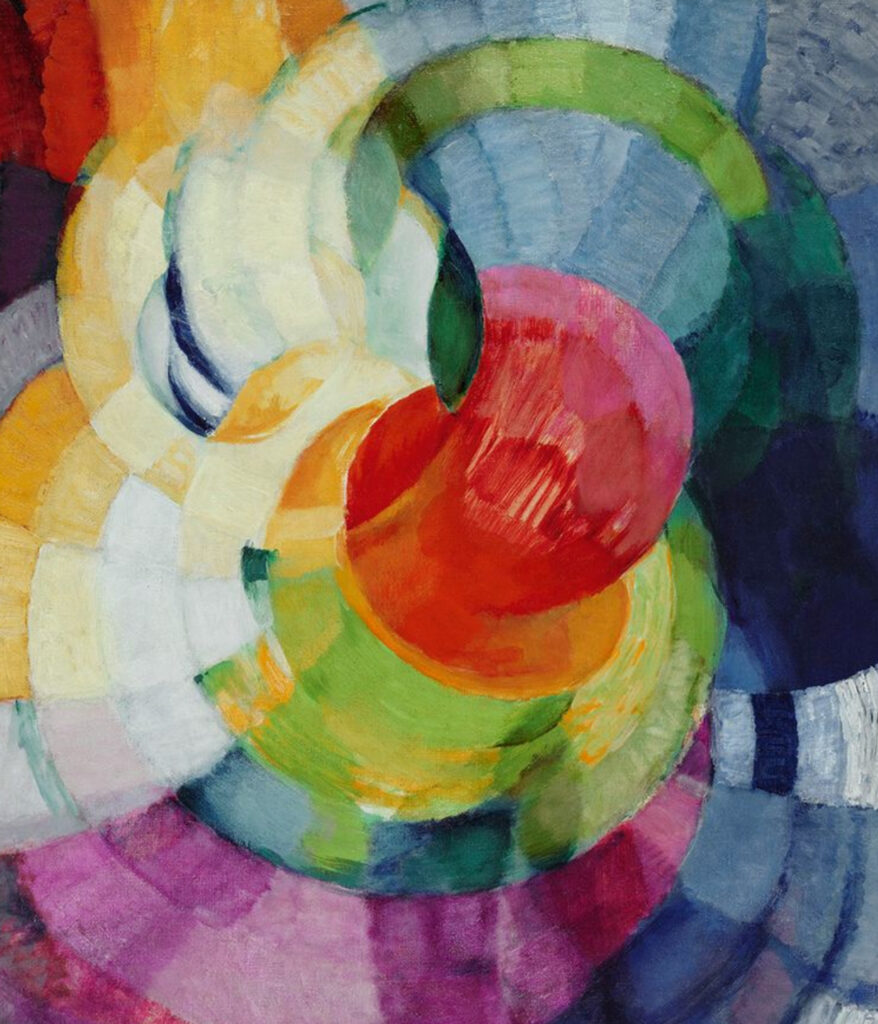František Kupka’s Disks of Newton (Study for Fugue in Two Colors) (1912) is one of the pioneering works of the Orphism movement, often described as a visual symphony that melds color, form, and scientific inquiry. This piece represents a significant leap toward abstraction, marking a departure from traditional figurative art and challenging the viewer’s perception of movement, light, and emotion through color alone. Rooted in Kupka’s fascination with Newtonian color theory, Disks of Newton transcends a mere scientific representation, pushing the boundaries of artistic expression and positioning itself as an important cultural artifact of early 20th-century modernism.
Kupka was deeply inspired by Sir Isaac Newton’s optical theories, which explored how light refracts to create the spectrum of visible colors. Newton’s work, while scientific, opened up new perspectives for artists seeking to understand and manipulate color in ways that go beyond traditional realism. Kupka approached color scientifically, much like Newton, but with a creative freedom that gave rise to Orphism—a movement grounded in Cubism but focused on the sensation of color and the rhythm of composition. Orphism, as championed by Kupka and Robert Delaunay, sought to create art that expressed an inner harmony or resonance through color arrangements, much like a piece of music does through notes. Kupka’s Disks of Newton stands as a crucial Orphic work, where form dissolves and the canvas becomes a realm of pure sensation.
In Disks of Newton, Kupka uses circular forms to evoke a sense of constant motion, mimicking the rhythmic pulsation of light as it interacts with the viewer’s eye. The concentric disks radiate outward, drawing the observer into a hypnotic whirlpool of colors that shift subtly from one tone to another, with reds, blues, greens, and yellows blending into one another to create a visual fugue. Kupka’s focus on circularity is symbolic; circles, unlike lines or angles, have no beginning or end, representing continuity and the infinite. This circular motif could be interpreted as a nod to Newton’s own idea of the “color wheel” and its boundless range of hues. At the same time, it reflects Kupka’s interest in spiritual philosophies that conceive of existence as a cyclical process. By layering these disks of color, Kupka creates an illusion of depth and space on a flat surface, inviting viewers to see beyond the tangible and experience a more transcendent form of art.
Kupka’s use of color in Disks of Newton is equally groundbreaking. Moving away from representational hues, he opts for a palette that is both bold and harmonious, layering colors in a way that almost suggests sound waves. This approach aligns with Kupka’s idea of visual art as a counterpart to music, where color becomes analogous to musical notes. The piece can be seen as a chromatic symphony, with each color playing a distinct role in the composition’s “melody.” Kupka’s art embraces the concept of synesthesia, where senses merge, allowing viewers to “hear” the colors or “feel” their vibration. This phenomenon, where one sensory experience leads to another, was a core tenet of Orphism and was central to the artistic experiments of the early modernist era. Kupka’s *Disks of Newton*, with its vibrant color fields and circular rhythm, becomes an immersive experience that engages not just the viewer’s visual sense but also evokes an almost physical response to color and form.
Another remarkable aspect of Disks of Newton is Kupka’s treatment of light. Unlike traditional paintings that rely on light and shadow to define objects, Kupka’s work rejects figurative depiction altogether. Instead, he uses color gradients to simulate the radiating quality of light. This abstraction of light transforms it into an ethereal presence that seems to emanate from within the painting. This approach was innovative in 1912 and reflected a radical departure from the realist traditions that had dominated Western art. By removing all references to the physical world, Kupka allowed his art to become a pure exploration of light and color. The work does not represent light as it interacts with objects; rather, it becomes a meditation on light as a phenomenon in itself. Through *Disks of Newton*, Kupka challenges the conventional role of light in painting, suggesting instead that color alone can evoke the essence of illumination.
The timing of Disks of Newton is also significant. Created in 1912, the work coincides with a period of great experimentation and upheaval in the art world. The early 20th century saw a rise in abstraction, as artists across Europe began rejecting traditional modes of representation in favor of more symbolic and expressive forms. Movements like Cubism, Futurism, and Expressionism all sought to break free from the constraints of realism, and Orphism emerged as a unique response that prioritized color as the primary means of expression. Within this context, Kupka’s work was radical, even within the avant-garde circles of Paris. His abstraction was less concerned with geometry and more with the emotional resonance of color, which he believed could communicate ideas more directly than representational forms.
Kupka’s Disks of Newton can be seen as a testament to the human impulse to explore the invisible forces that shape our world. Just as scientists seek to understand physical laws, artists like Kupka attempt to grasp the invisible forces of perception and emotion. The work’s circular patterns might represent unity or the unbreakable laws of the universe, hinting at the mystical or spiritual significance Kupka saw in art. While rooted in science, Kupka’s interpretation of color and light surpasses empirical knowledge, delving into the philosophical realm where art becomes a reflection of the universe’s inner workings. By transforming Newton’s color theory into a visual experience, Kupka bridges science and spirituality, showing that art can serve as both a mirror and a window—reflecting the known world and revealing the unknown
František Kupka’s Disks of Newton is more than an early abstraction; it is a fusion of art, science, and mysticism. Kupka’s engagement with Newton’s theories of color and light is not merely an intellectual exercise but a heartfelt inquiry into the nature of perception and its role in human experience. Through its mesmerizing color patterns and circular rhythms, *Disks of Newton* opens a pathway for viewers to connect with the intangible, to experience the resonance of colors as they would a piece of music. Kupka’s work does not simply ask us to look but to feel and respond to the language of color and form, making it a timeless piece that resonates with the core of human curiosity and wonder.
No comments yet.








